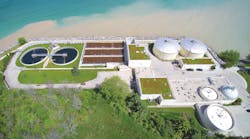The municipal wastewater treatment plant in Port Washington, serves the Wisconsin city of about 12,000 people. The fishing village, north of Milwaukee, is popular for sportfishing and attracts many lakefront tourists during the summer and fall.
This article is part of our monthly What Works column. Read more from our monthly What Works series.
The plant is located along the coast of Lake Michigan, where part of the lake was filled in to house the facility, so its footprint is limited for expansion but adequate for its processes. The plant is rated for 3.1 million gallons per day. It has a peak flow rating of 13 million gallons per day and processes more than 500 million gallons of wastewater annually.
“We don’t have storage capacity, so we have to treat everything as it comes in,” says Dan Buehler, wastewater treatment plant superintendent. To process the wastewater, three screw pumps at the head of the pump lift the water up about 20 feet, where it goes through a ½-inch bar screen. After that, the wastewater goes through grit removal, and then chloride is added for phosphorus removal later (the chloride is added early on to promote mixing). The small footprint prevents the use of primary clarifiers, so from grit removal, the wastewater goes directly into the aeration tanks, where it spends about a day. It is biologically treated in three tanks, 100 feet long by 30 feet wide by 18 feet deep, totaling about 1.3 million gallons. After aeration treatment, the wastewater goes through two final clarifiers, then UV treatment. The final effluent travels through a 1,500-foot pipe to the harbor at Port Washington. “We’re in close proximity to the water filtration plant, and we don’t want to discharge where most of their intake is,” Buehler says.
Aeration tank suspension
To power the air needed for its aeration tanks, running 24/7, the plant uses an Atlas Copco ZS 110 VSD (variable speed drive) screw blower. The screw blower was installed in 2011 and has run about 77,000 hours with zero downtime. Previous to the screw blower, the plant was using four multi-stage centrifugal blowers. Critical infrastructure standards require redundancy to be built into the system, so if one blower goes down, the plant has a backup, so it continues to use three of the older blowers. Also, Buehler says occasionally the plant still needs to use multiple blowers. In the summertime, it can be harder to get dissolved oxygen into the wastewater, when it’s warmer. Since installing the screw blower, Buehler estimates that the plant uses two blowers about 3% of the time.
Multiple blowers used to be common practice for the wastewater treatment plant to meet the varying demand, but the one rotary screw blower has done the job of multiple blowers. The wastewater plant has great swings in demand throughout the day, where demand is high in the morning, when everyone wakes up, and very low overnight. “Typically, at night the blower goes into maintenance mode. At the lowest level, we can run it but still keep things suspended in the aeration tank,” Buehler says.
When considering traditional tri-lobe blowers, the plant needed multiple blowers to meet that widely fluctuating demand. Using external compression, these blowers push air into the pipe, where all the compression happens in the pipe. “As a result, it’s not very efficient,” says Paul Petersen, municipal sales manager for Atlas Copco. “With a rotary screw, we actually use internal compression, meaning we squeeze the air inside the blower compression element. By doing that, we cut a portion of the working area out from under the curve. The area we cut out of the curve is the energy savings.” He says the energy savings equate to roughly 30 percent, compared to traditional blower technology.
The other benefit of the internal compression used in the helical screw, Petersen says, is lower heat production. “The turndown range of a positive displacement blower is typically limited to the rate of thermal expansion, meaning if you go slow enough eventually it will heat up too much,” he says. Once metal heats up and swells, it will lock up. The screw blower operates at a lower temperature because it can run at slower speeds more efficiently. “That’s what gives it a wide operating range,” Petersen says.
The variable speed drive allows the blower to cycle high when demand is high and run lower when demand is slow. Multistage centrifugal technology, though very efficient at a fixed point, has a much narrower operating range, Petersen says. One blower on a variable speed drive can meet the demand, low or high, and the plant avoids turning motors on and off. The demand of starting a multistage blower, over and over, not only adds up energy demand over time, but it can also add extra maintenance from repeated on/off operation.
Maintenance and savings
Standard maintenance on the machine includes changing air and oil filters every six months, and changing the oil every other year. The Port Washington wastewater treatment plant has an add-on service contract with Atlas Copco, including inspections twice a year. “We go through and verify the temperatures and pressures are within correct operating ranges, as well as vibration analysis,” says Steven Exner, service manager for municipal blowers at Atlas Copco. He says vibration data has been collected since the machine was first installed. “That way, we can predictively suggest repairs, or prevent any type of a bearing failure they might experience,” Exner says.
Petersen said the service contract with Port Washington is one of the lower levels of service Atlas Copco offers. The plant personnel at Port Washington do a lot of the regular maintenance and operate confidently. Buehler says maintenance staff check oil levels weekly. “We walk through the blower room every day to listen to it,” he says.
“For other plants, some of which are unmanned, they might not have personnel at the plant when it’s operating, or where they maybe don’t have experienced mechanics or maintenance on staff, we offer plans as high as total responsibility,” Petersen says.
The screw blower at Port Washington has earned the plant an estimated $190,000 in energy savings during its lifetime. “I looked at a lot of before and after electric bills,” Buehler says. He also did some measurements with electricians to gauge power usage, and he estimates the screw blower to be anywhere from 15 to 28 percent more efficient than the plant’s old setup.
Earlier this year, the wastewater plant decided to invest in another Atlas Copco screw blower, its newest upgrade, the ZS 5 version. Petersen says the new design is 5% more efficient than the original screw blower design. “Our design engineers in Belgium went through an iterative design process to improve the efficiency of the element specifically with what they call port tuning,” Peterson says.
Buehler also says the wastewater plant is planning major upgrades in three years to automate much of the process. “We’re going to have better control of the air,” he says. With flow meters to each quadrant and aeration tank, the plant will be able to control those individually. “Right now we just have manual valves, and we have to manually adjust,” Buehler says.
Since the COVID-19 pandemic, the plant hasn’t seen any increases in water volumes, but it has seen a large increase in disinfectants to the system, which does cause additional challenges. The plant is considering options to add other chemicals or bacterial augmentation to deal with the effects of the added disinfectants.


